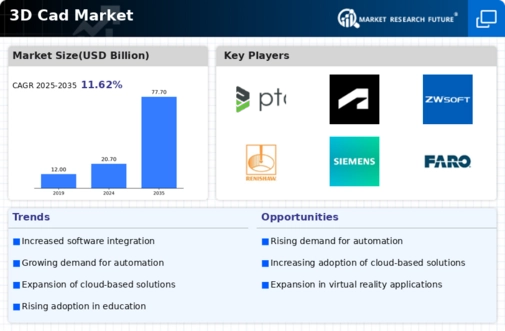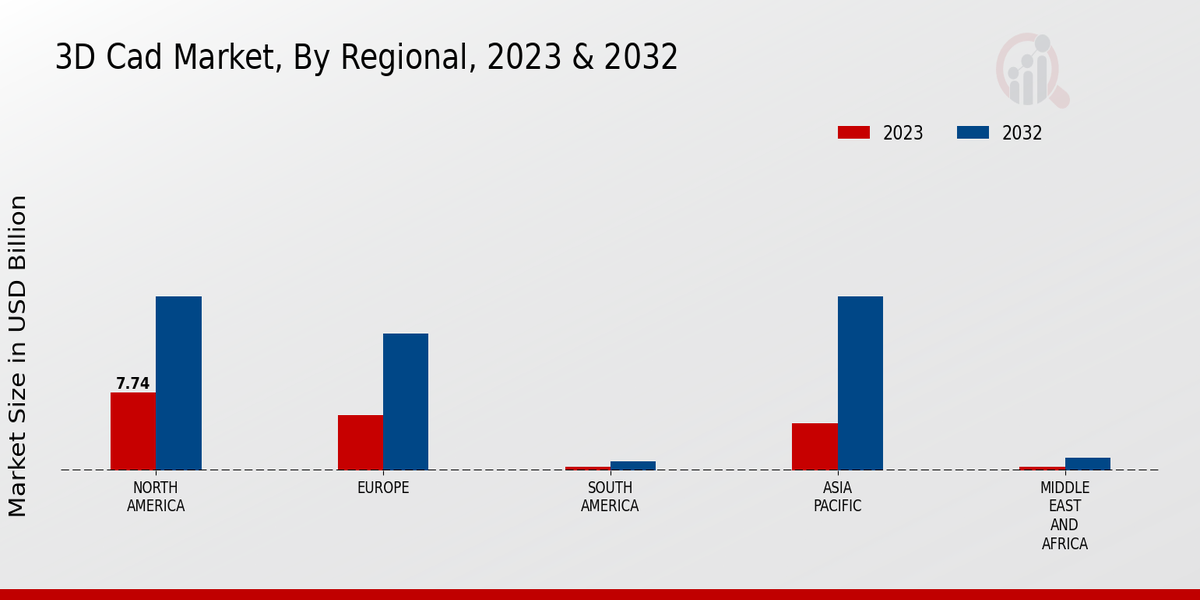Market Growth Projections
The Global 3D Cad Market Industry is projected to experience substantial growth over the next decade. With a market value of 20.7 USD Billion in 2024, the industry is expected to expand significantly, reaching 77.7 USD Billion by 2035. This growth trajectory suggests a compound annual growth rate of 12.8% from 2025 to 2035. Such projections indicate a robust demand for 3D CAD solutions across various sectors, driven by technological advancements and increasing adoption in emerging markets. The anticipated growth reflects the industry's potential to transform design and manufacturing processes globally.
Technological Advancements
The Global 3D Cad Market Industry is experiencing rapid growth driven by technological advancements in software and hardware. Innovations such as cloud computing, artificial intelligence, and machine learning are enhancing the capabilities of 3D CAD tools, making them more accessible and efficient. For instance, cloud-based solutions allow for real-time collaboration among teams, which is increasingly vital in a globalized economy. This trend is expected to contribute significantly to the market's expansion, with projections indicating a market value of 20.7 USD Billion in 2024, and a potential increase to 77.7 USD Billion by 2035, reflecting a robust CAGR of 12.8% from 2025 to 2035.
Growing Adoption of 3D Printing
The Global 3D Cad Market Industry is significantly influenced by the growing adoption of 3D printing technologies. As 3D printing becomes more prevalent, the need for compatible 3D CAD software is increasing. Industries such as manufacturing and healthcare are utilizing 3D printing for rapid prototyping and customized solutions, which necessitates advanced design capabilities. This synergy between 3D CAD and 3D printing is expected to drive market growth, with projections indicating a market value of 20.7 USD Billion in 2024 and a remarkable increase to 77.7 USD Billion by 2035. The CAGR of 12.8% from 2025 to 2035 highlights the potential for expansion in this sector.
Rising Demand in Various Industries
The Global 3D Cad Market Industry is witnessing heightened demand across various sectors, including automotive, aerospace, and architecture. These industries are increasingly adopting 3D CAD solutions to enhance design precision and streamline production processes. For example, the automotive sector utilizes 3D CAD for prototyping and testing, which significantly reduces time-to-market. As industries continue to recognize the benefits of 3D CAD, the market is poised for substantial growth. The projected increase in market value from 20.7 USD Billion in 2024 to 77.7 USD Billion by 2035 underscores the growing reliance on advanced design tools across multiple sectors.
Emerging Markets and Global Expansion
The Global 3D Cad Market Industry is benefiting from the expansion into emerging markets, where industrialization and technological adoption are on the rise. Countries in Asia-Pacific and Latin America are increasingly investing in advanced manufacturing technologies, including 3D CAD solutions. This trend is fostering a more competitive landscape, as local companies adopt these tools to enhance their design and production capabilities. The anticipated growth in these regions is expected to contribute to the overall market value, which is projected to reach 77.7 USD Billion by 2035. This expansion indicates a broader acceptance of 3D CAD technologies worldwide.
Increased Focus on Product Development
In the Global 3D Cad Market Industry, there is an increasing emphasis on product development and innovation. Companies are leveraging 3D CAD tools to create more sophisticated and user-friendly products, which can lead to competitive advantages. This focus on innovation is particularly evident in the consumer electronics and medical device sectors, where rapid prototyping and iterative design processes are essential. As organizations strive to meet consumer demands for high-quality products, the adoption of 3D CAD is likely to accelerate. The anticipated growth trajectory, with a market value reaching 77.7 USD Billion by 2035, reflects this trend.












